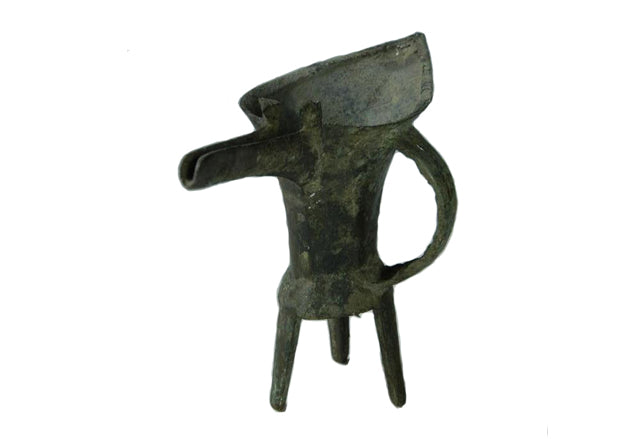
Narrow flow flat bottom jue

Narrow spout flat bottom jue, bronze, late Xia Dynasty, total height 14.50 cm, length from spout to tail 19.50 cm, foot height 4.30 cm. Now in the collection of Henan Museum.
In 1974, the people of Xincun Township, Xinzheng County (now Xinzheng City), Henan Province, found the artifact when they were leveling the Wangjing Tower site. It was later handed over to Xinzheng County Cultural Center for preservation. In May 1983, it was transferred to Xinzheng County Cultural Relics Conservation Institute for collection. In December 1997, it was transferred to Henan Provincial Museum (now Henan Museum).
Narrow spout flat bottom jue, narrow and long spout, pointed tail, thickened lip, two underdeveloped small columns at the spout tail, long waist, extremely shallow bulging belly, flat bottom, triangular pyramid foot below, one side has a handle, the handle is semicircular with perforations, the belly wall is thin, simple and without patterns. The Jue has a simple shape. Although it was unearthed from the Wangjinglou site in Xinzheng, it is very similar to the bronze Jue unearthed from the Erlitou site and has obvious characteristics of an early bronze Jue. Therefore, experts date it to the late Xia Dynasty, the same period as the bronze Jue unearthed from the Erlitou site.
The bronze vessels of the Erlitou culture period are the earliest bronze vessels discovered so far, including the earliest known bronze ritual vessels such as Jue, Jia, and Ding. Among them, the number of Jue is the largest. They are all cast from composite ceramic molds, and the casting process has a qualitative leap compared with the previous methods of using single-sided molds or double-sided molds.
Ceramic mold casting is the basis for studying the casting technology of bronze ware in the Shang and Zhou dynasties. It not only occupies a dominant position among all kinds of casting methods at that time, but also copper molds, iron molds and even lost wax methods are all derived from ceramic mold casting. Regardless of the shape, type and forming process, the bronze casting technology of the Erlitou site is a representative of the early bronze casting technology in China's Bronze Age. In the late Erlitou culture, the basic pattern and basic characteristics of China's bronze civilization and smelting technology have been formed. In terms of the forming process, although the bronzes cast during the Erlitou period were relatively small and crude, most of them had no patterns or simple patterns, and the casting techniques were obviously primitive, all the bronzes were cast by casting, and the bronze vessels were cast using the composite ceramic mold method, which clearly showed the development direction of the metal craft tradition of the Shang and Zhou dynasties. [1] The study of bronzes from the Erlitou period, especially the casting process of bronze vessels, is of great significance for the study of metallurgy, casting technology and cultural traditions of the Chinese Bronze Age.


![8.3"China Shang Dynasty,Bronze wine cup [Fuhao Jue cup][妇好爵杯]](http://bronzc.com/cdn/shop/files/4ee0482982cfa89bb4d1cff3333a55e6_e3ca0b86-22fc-497d-9afd-578c551225a3-2.jpg?v=1733986652&width=533)

![12.8" China Ming Dynasty, Phoenix-patterned bronze vase[Ming Wanli Phoenix-patterned vase][明万历凤纹瓶]](http://bronzc.com/cdn/shop/files/4ee0482982cfa89bb4d1cff3333a55e6_a516991b-2bb9-4b2f-a2b6-4354129d006c.jpg?v=1733986953&width=533)

![14.6" China Eastern Han Dynasty Bronze vessel in the shape of a flying horse,Also known as bronze galloping horse[Horse Stepping on Flying Swallow][马踏飞燕]](http://bronzc.com/cdn/shop/files/4ee0482982cfa89bb4d1cff3333a55e6_aa3fbeb8-e08b-4a44-929a-13411ca8fb17-2.jpg?v=1733987211&width=533)

![5.9"China Tang Dynasty, Bronze of a walking dragon[Tang Walking Dragon][唐走龙]](http://bronzc.com/cdn/shop/files/2_8cb416b9-ebbd-4fe2-a905-b9277f820c16.png?v=1731488701&width=533)
